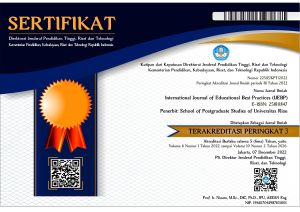A NEEDS ASSESSMENT APPROACH TO ENGLISH FOR SPECIFIC PURPOSES (ESP) BASED SYLLABUS DESIGN IN BANGLADESH VOCATIONAL AND TECHNICAL EDUCATION (BVTE)
DOI:
https://doi.org/10.31258/ijebp.2.2.18-25Keywords:
Needs analysis, Learner's needs, Syllabus design, ESP, BVTEAbstract
This paper describes the initial phase of a needs analysis which is developed in the context of Bangladesh Vocational and Technical Education (BVTE) with the aim to identify the needs of a target group of learners and introduce English for Specific Purposes (ESP) course design. Although the compulsory English for Academic Purposes (EAP) courses have been used at various programs of BVTE since 1996, they were not based on any systemic Needs Analysis nor have they been subjected to any evaluation. The paper also aims to conducts a Needs Analysis to obtain data which will be used to develop a meaningful, useful and beneficial, common core ESP programme for Bangladesh Vocational and Technical Board (BVTB) students. This process takes into account the needs of the various stakeholders involved including the policy makers, decision-makers, subject and language teachers and prospective employers. It mainly will make use of Hutchinson and Waters’ (1987) Learning-centred approach, Holliday and Nunan’s (1988) Needs Analysis description for conducting the Needs Analysis and specifying the content for a common-core ESP course. A mix method is adopted with questionnaires, semi-structured interviews, classroom observation and document study being the main data gathering tools, in order to ensure triangulation of data.
References
Aziz, J. (2017). European Journal of English Language Teaching Needs Analysis of
Bangladeshi English Language Learners at A Tertiary Classroom. European
Journal of English Language Teaching, 3(2).
Bosher, S., & Smalkoski, K. (2002). From needs analysis to curriculum development:
designing a course in health-care communication for immigrant students in the
USA. English for Specific Purposes, 21(1), 59–79.
Bazyar, Zahra, Mehdi Dastpak, A. T. (2015). Syllabus Design and Needs Analysis of
Students in Educational System. Advances in Language and Literary Studies.
Banu, R. & Sussex, R., (2001b). English in Bangladesh after Independence. In B. Moore
(Ed.) Who’s centric now? The present state of post-colonial English (122-147).
Melbourne: Oxford University Press
Banu, R. (1993). A Comparative Needs Analysis: Bangladeshi Students at IML and one
Japanese student at Georgetown University. In Journal of the institute of Modern
Languages (ed.). AHM Abdul Hye. Dhaka University Press.
Banu, R. 1993 A Comparative Needs Analysis: Bangladeshi Students at IML and one
Japanese student at Georgetown University Journal of the institute of Modern
Languges ed. AHM Abdul Hye
Canagarajah, A. S. (1993). Critical Ethnography of a Sri Lankan classroom: ambiguities
in student opposition to reproduction through ESOL TESOL Quarterly 27/4601
26)
Canagarajah, S. (1999). Resisting Linguistic Imperialism in English Teaching; Oxford,
OUP
Chandra Sekhar Rao, V., & Sekhar Rao, C. (2017). A Model English Syllabus Design for
The Students of Science and Technology. Issue 3, 1.
Chostelidou, D. (2010). A needs analysis approach to ESP syllabus design in Greek
tertiary education: A descriptive account of students’ needs. In Procedia - Social
and Behavioral Sciences.
Chostelidou, D. (2011). Needs-based course design: The impact of general English
knowledge on the effectiveness of an ESP teaching intervention. In Procedia -
Social and Behavioral Sciences.
Choudhury S.I. (2001). Rethinking the two Englishes. Revisioning English in
Bangladesh, pl5-27. UPL
Chowdhury, S. I. (2005, September). ‘ELT in context: Future directions’. Inaugural
Speech at 3rd International BELTA Conference, The British Council, Dhaka.
Creswell, J. W. (2003). Research design: Qualitative, quantitative, and mixed methods
approaches (2nd ed.). Thousand Oaks, CA: Sage.
Deutch, Y. (2003). Needs analysis for academic legal English courses in Israel: A model
of setting priorities. Journal of English for Academic Purposes.
Hutchinson,T.and Waters,A. 1987 English for specific purposes Cambridge: Cambridge
University Press.
Khan, R. (2000). The English foundation course at Dhaka University: An evaluation. The
Dhaka University studies, Part A, 57(1), 77-110.
Khan, R. S. (2004). Language planning in Bangladesh: A case study. In S. Mansoor, S.
Meraj, & A. Tahir (Eds), Language policy Planning and Practice: A South Asian
Perspective (pp. 112-122). Karachi: The Aga Khan University & Oxford
University Press, Pakistan.
Long, M. H. (2005). Methodological issues in learner needs analysis. In M.H. Long (Ed.),
Second language needs analysis (pp.19-76). Cambridge: Cambridge University
Press.





